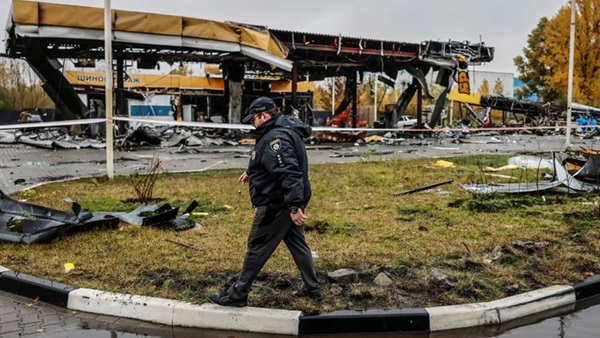Ukraine Calls for More Air-Defense Help as Russian Barrages Continue

Ukraine
called for more air-defense systems from the West to defend itself against
Russian missile-and-drone attacks that have targeted its energy infrastructure
in recent weeks, a senior Ukrainian official said Wednesday.
Andriy
Yermak, the chief of Ukraine’s presidential staff, said he requested additional
air defenses in calls with U.S. national security adviser Jake Sullivan and
senior French and British officials.
Air defense
is becoming a critical new front in the war after Russia launched a series of
aerial attacks that have wreaked havoc on Ukraine’s electrical infrastructure
in a campaign designed to leave residents in the cold and dark as winter
approaches, according to Ukrainian officials.
Ukraine’s
air defenses, including a patchwork of Soviet-era systems, achieved surprising
success against Russian warplanes and helicopters in the early days after
Russia invaded in February, denying the Russian military control of the skies.
But in
recent weeks, Russia has launched waves of missiles and Iranian-made drones
that pose a new problem for Ukrainian air defenses. Low- and slow-flying drones
represent a technical challenge for a previous generation of air defenses
designed to shoot down jet fighters and helicopters, military analysts say.
Russian forces have also used barrages of dozens of missiles and drones to
overwhelm Ukrainian defenses.
Those recent
attacks have reached deep into western and central Ukraine, disrupting the
relative calm that prevailed after Ukraine forced Russian forces to withdraw
from areas near the capital, Kyiv, in April. The attacks have knocked out the
water and electricity to broad sections of Ukraine, raising anxieties among
Ukrainians and heightening concerns in Europe about another possible wave of
refugees leaving the country.
“We need air
defense systems as soon as possible,” Mr. Yermak said in a social-media post.
The General
Staff of Ukraine’s armed forces said in its morning update on Wednesday that
Russia had launched five rocket attacks and up to 30 airstrikes at more than 40
settlements across the country, including in the Kharkiv, Dnipropetrovsk and
Kherson regions.
“Violating
the norms of International Humanitarian Law, the laws and customs of war,
[Russia] continues to strike critical infrastructure and the homes of the
civilian population,” the general staff said.
Ukraine’s
southern air command said later its forces shot down a Russian Ka-52 attack
helicopter in the Kherson region on Wednesday evening.
Separately,
Ukrainian officials said Wednesday that a Russian missile strike on a gas
station in Dnipro had killed two people, including a pregnant woman. Four
others were wounded in the attack, the regional governor said in a social-media
post that included images that appeared to show the charred remains of a gas
station and a hatchback car.
Russia’s
attacks on areas far from the front lines in eastern Ukraine come as the
Kremlin’s forces are losing ground to a Ukrainian offensive that has reclaimed
a swath of territory previously occupied by the Russian military.
Ukrainian
forces are on the offensive in northeastern and southeastern Ukraine, where
they have rolled back Russian advances in recent weeks. Russian forces have
continued to go on the offensive in two other areas, around the towns of
Avdiivka and Bakhmut, though with little success.
“The enemy
is shelling the positions of our troops along the contact line, carrying out
fortification equipment of positions in certain directions and conducting
aerial reconnaissance,” the Ukrainian general staff said.
On Tuesday,
the chief executive officer of Raytheon Technologies Corp. said the weapons
maker had delivered mobile air-defense systems known as Nasams, which are
capable of shooting down drones, missiles and airplanes. CEO Greg Hayes said in
an interview with CNBC television that the two systems were being installed
imminently.
The short-
and medium-range Nasams could become part of a layered approach to air defense
that Ukraine needs to defend itself against the complex threat of Russian
drones, cruise missiles, ballistic missiles and jet fighters, Western officials
say.
The Pentagon
has said the U.S. is sending two Nasams to Ukraine within the next two months.
Another six Nasams systems have been earmarked for Ukraine, but Pentagon and
industry officials said it could take around 18 months or more to finish and
deliver them.
Earlier in
October, Germany delivered the first of four Iris-T medium-range missile
systems.
Mark F.
Cancian, a retired Marine colonel and senior adviser at the Center for
Strategic and International Studies, a think tank in Washington, said the newly
delivered American and German systems weren’t enough to cover Ukraine’s exposed
infrastructure and cities throughout its territory, an area nearly the size of
Texas.
“It’s
symbolic more than it provides a real military capability,” he said of the new
deliveries.
The U.S. and
European countries deactivated much of their ground-based air defenses at the
end of the Cold War, meaning that the West likely doesn’t have enough systems
that it could feasibly deliver to Ukraine in the short term, said Mr. Cancian.
“The general
problem is there just isn’t a whole lot of inventory to give away,” he said.
Separately, Ukraine’s Mr. Yermak said Wednesday that 10 Ukrainian servicemen as well as the body of U.S. Army veteran Joshua Jones, who had died while fighting for Ukraine as a volunteer, had been returned to Ukraine in a prisoner exchange with Russia.
The U.S.
State Department confirmed the remains of a U.S. citizen killed in the fighting
in Ukraine had been identified and would soon be returned to the deceased’s
family. In a statement, the department didn’t provide the name of the deceased
American and reiterated its plea that U.S. citizens not travel to Ukraine.





